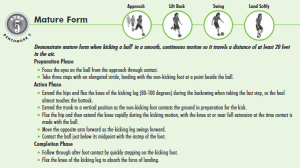| Equipment | Set-Up | |
|---|---|---|
| Skill Development Equipment/Set-up |
|
|
Skill Development: Instep Kick and Foot Trap
This skill development focuses on instruction and practice of kicking a ball with the dominant foot with a continuous moving approach and with a moving ball. It includes exploration of stopping a ball from moving on the ground by using a foot trap. The EPEC Classic TLP for instep kick is used for instruction and form corrections, with focus on steps 1 & 5 (Step 5 is mature form). The second grade GLO is to use a continuous running approach and kick a moving ball.
Prepare:
Say to students:
- Now let’s focus on improving our skills using our legs and feet with the ball so that you can participate well in lots of different games.
- In many games you will need to know how to kick a ball and stop it from moving while it is on the ground.
- Knowing these skills will help you feel more confident about joining in to move and play.
- We practiced these skills together last year. Let’s learn more about these skills and how we can practice and improve them.
- Remember, when we are practicing, we want to use safe equipment handling, responsibility with the balls, and want to work well with partners to have the best practice possible.
Instep Kick & Ball Trap
Explain/Demonstrate
- Ask half of the students to move safely to a space spot and stand on it.
- Then ask the other half to stand an arm’s length behind a student who is already on a spot to be their practice partner.
- Use the EPEC Classic Instep kick TLP to review and for form corrections.
- Review with students:
- Where the instep is located on the foot (laces part of shoe).
- How to use their non-dominant foot to take a big step beside the ball (cone), backswing with their dominant foot toward the bum, and swing their non-dominant arm and extending leg/foot to follow through to kick.
- That their favorite foot is the one that will follow through and contact the ball.
- Ball of foot trap to stop the ball from moving.
Practice: Ball to Wall – Stationary Ball
- Share that they will now get the chance to try their instep kick with a ball.
- Explain that it is easier to kick a ball that is still (stationary) from a standing still position, and they will be practicing it this way first.
- Demonstrate how they will try to instep kick their ball to the wall then run out to stop the ball from moving by using the foot trap on the ball. Then they may pick the ball up with their hands and re-set it for their partner to practice.
- Explain that they will continue taking turns and practicing, using your cue words to try to give the best kicks that they can.
- Position a ball in front of each student standing on a space spot.
- Ask first partners to show readiness.
- Call cue words aloud to coach them to use their best body form (e.g., ready, eyes on, favorite foot in front, big step beside, swing back to bum, arm action, point foot and follow through, run to trap, reset and switch places with your partner).
- Continue skill practice until each student has had 5-8 turns.
Practice: Ball to Wall – Run toward Ball
- Share with students that to get the ball to go farther and faster, they will try to run towards it before kicking.
- Direct them to move their space spot back approximately 10 feet from the ball and start in ready position on their space spot.
- Demonstrate how they should try to move smoothly when approaching the ball, place their big step beside the ball, and continue with their kick. (Emphasize continuous motion)
- Share that this skill takes a lot of practice to do well, so it may feel a bit tricky at first.
- Explain that the more they practice the more comfortable it will feel and look.
- Ask first partners to show readiness.
- Call cue words aloud to coach them to use their best body form (e.g., ready, eyes on, favorite foot in front, move/run smoothly, big step beside ball, swing back to bum, arm action, point foot and follow through, run to trap, reset and switch places with your partner).
- Continue skill practice until each student has had 5-8 turns.

Transition:
Ask students to low-five or pinky shake with their practice partner, return their ball to the designated spot, and sit down in their team position.
| Variations: | A deck ring may be used to keep ball stable/in place as students try to approach. |
|---|